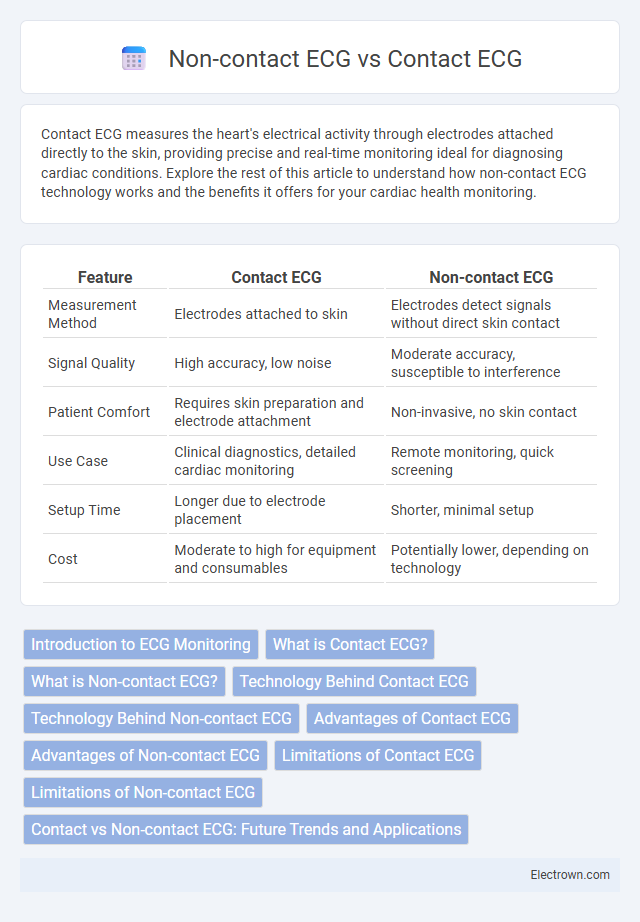Contact ECG measures the heart's electrical activity through electrodes attached directly to the skin, providing precise and real-time monitoring ideal for diagnosing cardiac conditions. Explore the rest of this article to understand how non-contact ECG technology works and the benefits it offers for your cardiac health monitoring.
Table of Comparison
| Feature | Contact ECG | Non-contact ECG |
|---|---|---|
| Measurement Method | Electrodes attached to skin | Electrodes detect signals without direct skin contact |
| Signal Quality | High accuracy, low noise | Moderate accuracy, susceptible to interference |
| Patient Comfort | Requires skin preparation and electrode attachment | Non-invasive, no skin contact |
| Use Case | Clinical diagnostics, detailed cardiac monitoring | Remote monitoring, quick screening |
| Setup Time | Longer due to electrode placement | Shorter, minimal setup |
| Cost | Moderate to high for equipment and consumables | Potentially lower, depending on technology |
Introduction to ECG Monitoring
ECG monitoring captures the electrical activity of the heart to assess cardiac health and detect abnormalities. Contact ECG uses electrodes placed on the skin to directly record heart signals, providing high accuracy and real-time data. Non-contact ECG leverages capacitive sensors without skin contact, offering comfort and convenience while monitoring cardiac function through your environment.
What is Contact ECG?
Contact ECG involves the direct placement of electrodes on the skin to measure the heart's electrical activity, ensuring accurate signal acquisition through physical contact. This method is commonly used in clinical settings due to its high precision and reliability in detecting cardiac abnormalities. Non-contact ECG, by contrast, detects heart signals without skin contact, typically employing capacitive or optical sensors, but often with lower signal fidelity compared to contact ECG.
What is Non-contact ECG?
Non-contact ECG measures the heart's electrical activity without physical electrodes touching the skin, using capacitive or optical sensors to detect cardiac signals remotely. This technology improves comfort and hygiene by eliminating the need for adhesive patches or gels commonly used in contact ECG devices. Your monitoring experience becomes less intrusive, enabling continuous heart rate tracking in clinical and wearable health applications.
Technology Behind Contact ECG
Contact ECG technology relies on electrodes placed directly on the skin to detect electrical signals generated by the heart, using conductive gels to enhance signal quality. These electrodes capture precise cardiac activity by measuring voltage differences between specific points on the body surface, enabling detailed heartbeat waveform analysis. Advanced contact ECG systems utilize multiple leads and high-resolution amplifiers to provide accurate and real-time monitoring of heart rhythms.
Technology Behind Non-contact ECG
Non-contact ECG technology utilizes capacitive coupling and advanced sensor arrays to detect cardiac electrical activity without direct skin contact, enabling monitoring through clothing or at a short distance. This method employs high-impedance amplifiers and sophisticated signal processing algorithms to filter out noise and enhance signal quality, distinguishing it from traditional contact-based electrodes that rely on direct skin contact. Your ability to monitor heart health non-invasively improves with this technology, making it more comfortable and accessible for continuous cardiac analysis.
Advantages of Contact ECG
Contact ECG offers superior signal accuracy by directly attaching electrodes to the skin, which minimizes motion artifacts and electrical interference. This method provides continuous and real-time monitoring, crucial for detecting transient cardiac abnormalities and arrhythmias. The high fidelity of contact ECG data supports precise diagnostics and effective treatment planning in clinical settings.
Advantages of Non-contact ECG
Non-contact ECG offers significant advantages such as enhanced patient comfort and reduced risk of skin irritation since it eliminates the need for adhesive electrodes. This method allows for continuous cardiac monitoring without disrupting daily activities, making it highly suitable for long-term surveillance. Your healthcare experience can be improved with non-contact ECG by providing real-time data while maintaining hygiene and convenience.
Limitations of Contact ECG
Contact ECG requires direct skin contact with electrodes, leading to issues such as skin irritation, discomfort, and motion artifacts that can degrade signal quality. These limitations restrict long-term monitoring and can be problematic for patients with sensitive skin or excessive sweating. Your ability to obtain accurate and continuous cardiac data may be compromised due to these physical and environmental constraints.
Limitations of Non-contact ECG
Non-contact ECG technology faces limitations such as susceptibility to motion artifacts and electromagnetic interference, which can affect signal accuracy and reliability. The lack of direct skin contact often leads to weaker signal strength and lower signal-to-noise ratios compared to traditional contact ECG systems. If you require precise cardiac monitoring, contact ECG remains superior for clinical diagnostics due to its consistent and high-fidelity recordings.
Contact vs Non-contact ECG: Future Trends and Applications
Contact ECG systems provide precise cardiac monitoring through direct skin electrodes, while non-contact ECG leverages capacitive sensors for remote, unobtrusive heart rate detection. Future trends indicate increased integration of non-contact ECG in wearable health tech and telemedicine, enhancing continuous monitoring without skin irritation. Applications expand into fitness tracking, sleep analysis, and early arrhythmia detection by combining AI algorithms with non-contact sensing for real-time, scalable cardiac care.
Contact vs Non-contact ECG Infographic

 electrown.com
electrown.com